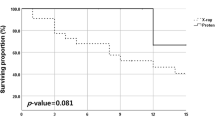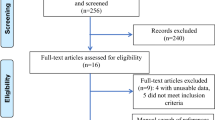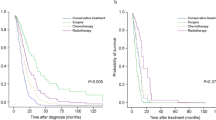Abstract
Objectives
To evaluate the safety and efficacy of microwave ablation (MWA) for stage I non-small cell lung cancer (NSCLC) in patients with idiopathic pulmonary fibrosis (IPF).
Materials and methods
A retrospective single-center cohort study was conducted in patients with clinical stage I NSCLC who underwent CT-guided MWA from Nov 2016 to Oct 2021. The patients were divided into the IPF group and the non-IPF group. The primary endpoints were 90-day adverse events and hospital length of stay (HLOS). The secondary endpoints included overall survival (OS) and progression-free survival (PFS).
Results
A total of 107 patients (27 with IPF and 80 without IPF) were finally included for analysis. No procedure-related acute exacerbation of IPF or death occurred post-MWA. The rates of adverse events were similar between the groups (48.6% vs. 47.7%; p = 0.998). The incidence of grade 3 adverse events in the IPF group was higher than that in the non-IPF group without a significant difference (13.5% vs. 4.6%; p = 0.123). Median HLOS was 5 days in both groups without a significant difference (p = 0.078). The 1-year and 3-year OS were 85.2%/51.6% in the IPF group, and 97.5%/86.4% in the non-IPF group. The survival of patients with IPF was significantly poorer than the survival of patients without IPF (p < 0.001). There was no significant difference for PFS (p = 0.271).
Conclusion
MWA was feasible in the treatment of stage I NSCLC in patients with IPF. IPF had an adverse effect on the survival of stage I NSCLC treated with MWA.
Clinical relevance statement
CT-guided microwave ablation is a well-tolerated and effective potential alternative treatment for stage I non-small cell lung cancer in patients with idiopathic pulmonary fibrosis.
Key Points
• Microwave ablation for stage I non-small cell lung cancer was well-tolerated without procedure-related acute exacerbation of idiopathic pulmonary fibrosis and death in patients with idiopathic pulmonary fibrosis.
• No differences were observed in the incidence of adverse events between patients with idiopathic pulmonary fibrosis and those without idiopathic pulmonary fibrosis after microwave ablation (48.6% vs. 47.7%; p = 0.998).
• The 1-year and 3-year overall survival rates (85.2%/51.6%) in the idiopathic pulmonary fibrosis group were worse than those in the non- idiopathic pulmonary fibrosis group (97.5%/86.4%) (p < 0.001).



Similar content being viewed by others
Abbreviations
- AEIPF:
-
Acute exacerbation of idiopathic pulmonary fibrosis
- CT:
-
Computed tomography
- ILD:
-
Interstitial lung disease
- IPF:
-
Idiopathic pulmonary fibrosis
- MWA:
-
Microwave ablation
- NSCLC:
-
Non-small cell lung cancer
- OS:
-
Overall survival
- PET/CT:
-
Positron emission tomography/computed tomography
- PFS:
-
Progression-free survival
- RFA:
-
Radiofrequency ablation
- RP:
-
Radiation pneumonitis
- SBRT:
-
Stereotactic body radiation therapy
- TA:
-
Thermal ablation
References
Kreuter M, Ehlers-Tenenbaum S, Schaaf M et al (2015) Treatment and outcome of lung cancer in idiopathic interstitial pneumonias. Sarcoidosis Vasc Diffuse Lung Dis 31:266–274
Saito Y, Kawai Y, Takahashi N et al (2011) Survival after surgery for pathologic stage IA non-small cell lung cancer associated with idiopathic pulmonary fibrosis. Ann Thorac Surg 92:1812–1817
Watanabe A, Miyajima M, Mishina T et al (2013) Surgical treatment for primary lung cancer combined with idiopathic pulmonary fibrosis. Gen Thorac Cardiovasc Surg 61:254–261
Watanabe N, Taniguchi H, Kondoh Y et al (2013) Efficacy of chemotherapy for advanced non-small cell lung cancer with idiopathic pulmonary fibrosis. Respiration 85:326–331
Omori T, Tajiri M, Baba T et al (2015) Pulmonary resection for lung cancer in patients with idiopathic interstitial pneumonia. Ann Thorac Surg 100:954–960
Watanabe A, Higami T, Ohori S, Koyanagi T, Nakashima S, Mawatari T (2008) Is lung cancer resection indicated in patients with idiopathic pulmonary fibrosis? J Thorac Cardiovasc Surg 136:1357–1363
Okamoto T, Gotoh M, Masuya D et al (2004) Clinical analysis of interstitial pneumonia after surgery for lung cancer. Jpn J Thorac Cardiovasc Surg 52:323–329
Ozawa Y, Suda T, Naito T et al (2009) Cumulative incidence of and predictive factors for lung cancer in IPF. Respirology 14:723–728
Postmus PE, Kerr KM, Oudkerk M et al (2017) Early and locally advanced non-small-cell lung cancer (NSCLC): ESMO Clinical Practice Guidelines for diagnosis, treatment and follow-up. Ann Oncol 28:iv1–iv21
Isobe K, Hata Y, Sakamoto S, Takai Y, Shibuya K, Homma S (2010) Clinical characteristics of acute respiratory deterioration in pulmonary fibrosis associated with lung cancer following anti-cancer therapy. Respirology 15:88–92
Genshaft SJ, Suh RD, Abtin F et al (2021) Society of Interventional Radiology multidisciplinary position statement on percutaneous ablation of non-small cell lung cancer and metastatic disease to the lungs: endorsed by the Canadian Association for Interventional Radiology, the Cardiovascular and Interventional Radiological Society of Europe, and the Society of Interventional Oncology. J Vasc Interv Radiol 32:1241.e1-1241.e12
Venturini M, Cariati M, Marra P, Masala S, Pereira PL, Carrafiello G (2020) CIRSE standards of practice on thermal ablation of primary and secondary lung tumors. Cardiovasc Intervent Radiol 43:667–683
Donington J, Ferguson M, Mazzone P et al (2012) Thoracic Oncology Network of the American College of Chest Physicians and the Workforce on Evidence-Based Surgery of the Society of Thoracic Surgeons. American College of Chest Physicians and Society of Thoracic Surgeons consensus statement for evaluation and management for high-risk patients with stage I non-small cell lung cancer. Chest 142:1620–1635
NCCN guidelines: treatment by cancer type (2022) www.nccn.org/guidelines/category_1. National Comprehensive Cancer Network (NCCN) website. Accessed 23 Feb 2022.
Lynch DA, Sverzellati N, Travis WD et al (2018) Diagnostic criteria for idiopathic pulmonary fibrosis: a Fleischner Society White Paper. Lancet Respir Med 6:138–153
Khalilzadeh O, Baerlocher MO, Shyn PB et al (2017) Proposal of a new adverse event classification by the Society of Interventional Radiology Standards of Practice Committee. J Vasc Interv Radiol 28:1432-1437.e3
Ley B, Ryerson CJ, Vittinghoff E et al (2012) A multidimensional index and staging system for idiopathic pulmonary fibrosis. Ann Intern Med 156:684–691
Chen H, Senan S, Nossent EJ et al (2017) Treatment-related toxicity in patients with early-stage non-small cell lung cancer and coexisting interstitial lung disease: a systematic review. Int J Radiat Oncol Biol Phys 98:622–631
Sänger JA, Graur A, Tahir I et al (2023) Outcomes following cryoablation of stage IA non-small cell lung cancer in patients with and without interstitial lung disease: a retrospective single-center cohort study. Lung Cancer 181:107231
Dassa M, Izaaryene J, Daidj N, Piana G (2021) Efficacy of tract embolization after percutaneous pulmonary radiofrequency ablation. Cardiovasc Intervent Radiol 44:903–910
Peng J, Bie Z, Su F, Sun J, Li X (2023) Effects of tract embolization on pneumothorax rate after percutaneous pulmonary microwave ablation: a rabbit study. Int J Hyperthermia 40:2165728
Jiang B, McClure MA, Chen T, Chen S (2018) Efficacy and safety of thermal ablation of lung malignancies: a network meta-analysis. Ann Thorac Med 13:243–250
Ambrogi MC, Fanucchi O, Cioni R et al (2011) Long-term results of radiofrequency ablation treatment of stage I non-small cell lung cancer: a prospective intention-to-treat study. J Thorac Oncol 6:2044–2051
Dupuy DE, Fernando HC, Hillman S et al (2015) Radiofrequency ablation of stage IA non-small cell lung cancer in medically inoperable patients: results from the American College of Surgeons Oncology Group Z4033 (Alliance) trial. Cancer 121:3491–3498
Moore W, Talati R, Bhattacharji P, Bilfinger T (2015) Five-year survival after cryoablation of stage I non-small cell lung cancer in medically inoperable patients. J Vasc Interv Radiol 26:312–319
Palussiere J, Chomy F, Savina M et al (2018) Radiofrequency ablation of stage IA non-small cell lung cancer in patients ineligible for surgery: results of a prospective multicenter phase II trial. J Cardiothorac Surg 13:91
Han X, Yang X, Huang G et al (2019) Safety and clinical outcomes of computed tomography-guided percutaneous microwave ablation in patients aged 80 years and older with early-stage non-small cell lung cancer: a multicenter retrospective study. Thorac Cancer 10:2236–2242
Wu J, Bai HX, Chan L et al (2020) Sublobar resection compared with stereotactic body radiation therapy and ablation for early stage non-small cell lung cancer: a National Cancer Database study. J Thorac Cardiovasc Surg 160:1350–1357
Ni Y, Huang G, Yang X et al (2022) Microwave ablation treatment for medically inoperable stage I non-small cell lung cancers: long-term results. Eur Radiol 32:5616–5622
Tomassetti S, Gurioli C, Ryu JH et al (2015) The impact of lung cancer on survival of idiopathic pulmonary fibrosis. Chest 147:157–164
Kumar P, Goldstraw P, Yamada K et al (2003) Pulmonary fibrosis and lung cancer: risk and benefit analysis of pulmonary resection. J Thorac Cardiovasc Surg 125:1321–1327
Sato T, Teramukai S, Kondo H et al (2014) Impact and predictors of acute exacerbation of interstitial lung diseases after pulmonary resection for lung cancer. J Thorac Cardiovasc Surg 147:1604-1611.e3
Onishi H, Yamashita H, Shioyama Y et al (2018) Stereotactic body radiation therapy for patients with pulmonary interstitial change: high incidence of fatal radiation pneumonitis in a retrospective multi-institutional study. Cancers (Basel) 10:257
Ueki N, Matsuo Y, Togashi Y et al (2015) Impact of pretreatment interstitial lung disease on radiation pneumonitis and survival after stereotactic body radiation therapy for lung cancer. J Thorac Oncol 10:116–125
Yoshitake T, Shioyama Y, Asai K et al (2015) Impact of interstitial changes on radiation pneumonitis after stereotactic body radiation therapy for lung cancer. Anticancer Res 35:4909–4913
Yamashita H, Kobayashi-Shibata S, Terahara A et al (2010) Prescreening based on the presence of CT-scan abnormalities and biomarkers (KL-6 and SP-D) may reduce severe radiation pneumonitis after stereotactic radiotherapy. Radiat Oncol 5:32
Bahig H, Filion E, Vu T et al (2015) Excellent cancer outcomes following patient-adapted robotic lung SBRT but a case for caution in idiopathic pulmonary fibrosis. Technol Cancer Res Treat 14:667–676
Funding
This work was funded by the National High Level Hospital Clinical Research Funding (BJ-2022–106), and the Central Healthcare Research Fund (No. 2020YB10).
Author information
Authors and Affiliations
Corresponding author
Ethics declarations
Guarantor
The scientific guarantor of this publication is XiaoGuang Li.
Conflict of interest
The authors of this manuscript declare no relationships with any companies, whose products or services may be related to the subject matter of the article.
Statistics and biometry
No complex statistical methods were necessary for this paper.
Informed consent
Written informed consent was waived by the Institutional Review Board.
Ethical approval
Institutional Review Board approval was obtained. The institutional review board approved this retrospective study (2020BJYYEC-227–01) and waived the requirement for informed consent.
Study subjects or cohorts overlap
Study subjects have not been previously reported in a published article.
Methodology
• retrospective
• observational
• performed at one institution
Additional information
Publisher's Note
Springer Nature remains neutral with regard to jurisdictional claims in published maps and institutional affiliations.
Rights and permissions
Springer Nature or its licensor (e.g. a society or other partner) holds exclusive rights to this article under a publishing agreement with the author(s) or other rightsholder(s); author self-archiving of the accepted manuscript version of this article is solely governed by the terms of such publishing agreement and applicable law.
About this article
Cite this article
Peng, J., Bie, Z., Li, Y. et al. Safety and efficacy of CT-guided percutaneous microwave ablation for stage I non-small cell lung cancer in patients with comorbid idiopathic pulmonary fibrosis. Eur Radiol (2023). https://doi.org/10.1007/s00330-023-10510-9
Received:
Revised:
Accepted:
Published:
DOI: https://doi.org/10.1007/s00330-023-10510-9




